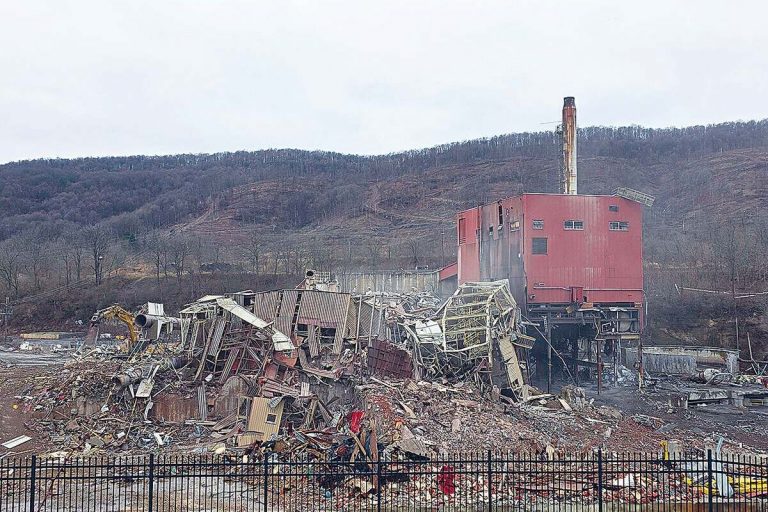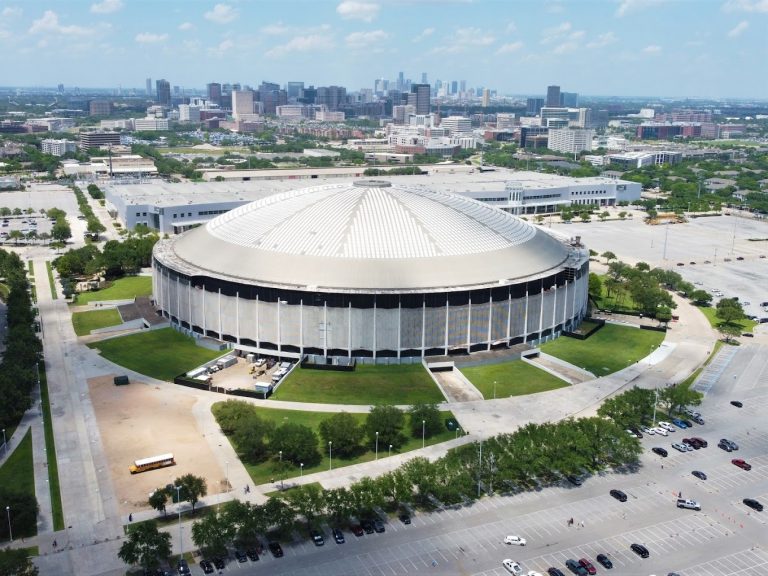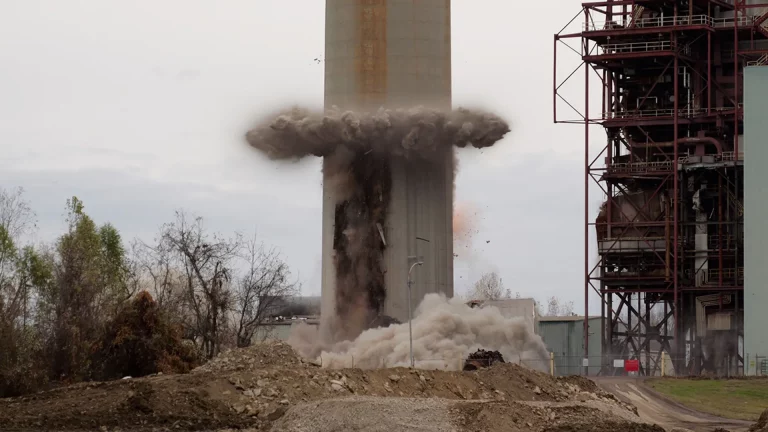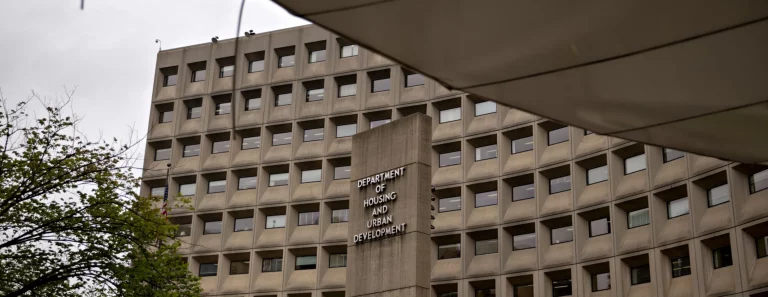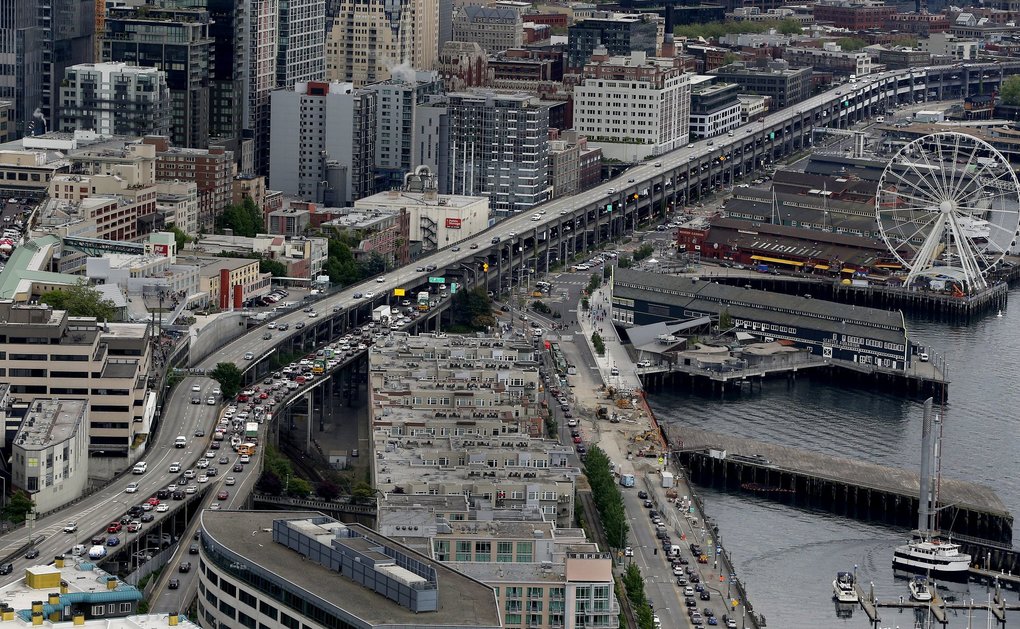
As many as five demolition crews will be munching and toppling sections of the old Alaskan Way Viaduct next spring, as workers attempt an all-out sprint to level the concrete leviathan within four months. Six days a week, they’ll break the decks and columns using machines with grasping tools shaped like lobster claws, which at volumes of up to 85 decibels will be louder than highway traffic. That work is allowed until 10 p.m. under a city noise permit meant to help the demolition be finished quickly. Quieter work such as trucking can continue overnight.
The waterfront will be a spectacle of netting, dust, roaring machines, and rubble being piled or trucked away. Screens will be hung over and below the condemned highway to protect buildings, some of which are within 10 feet. The heavy machines will be equipped with metal jaws that bite the concrete several times to partly pulverize rubble before it falls to the ground. These chompers make less noise than old-style impact hammers, which pound a heavy steel piece into the deck. Major work could start by early February when the new, four-lane Highway 99 tunnel opens, to replace the viaduct after it closes forever Jan. 11.
Rapid work is one highlight of a winning 258-page proposal by Kiewit Infrastructure, which the state released this week to The Seattle Times after a public-documents request. Viaduct demolition, by subcontractor FERMA, is a $40 million phase of Kiewit’s overall $94 million contract that includes decommissioning the old Battery Street Tunnel, and building new street connections along lower Aurora Avenue North. Exact schedules are still being negotiated, said Laura Newborn, project spokeswoman for the Washington State Department of Transportation (WSDOT). Timelines are in flux. WSDOT hoped to make its viaduct-to-tunnel changeover this fall but decided to wait until after New Year’s to avoid risk that slight delays or rainstorms might push the expected traffic jams into the holiday season.
Although the bid showed early work by November and all-out razing Jan. 2, those dates will slide by weeks, so that Kiewit’s goal to finish May 9 could stretch into June. The original bid promised only 128 days to tear down the main portions of the viaduct, which Kiewit says would be a full 142 days faster than the state required.
Among the first parts to fall will be northern decks near Pike Place Market. That will make room for the city of Seattle to start building the landscaped Overlook Walk, from the market down to Seattle Aquarium. Demolition crews will generally work from top to bottom in each group of decks. This requires keeping Elliott Avenue and Seneca Street ramps in place until later stages, so the heavy machinery can drive onto viaduct decks.
Crews will work in three-span sections. If you look at the structure today, the viaduct consists of triple-spans separated by gaps between each trio to serve as expansion joints. Top decks will be removed, followed by vertical columns, then the lower decks. Foundations must be sawed five feet underground. Pedestrian access to the state ferry terminal will be maintained throughout. Kiewit will install a temporary steel-truss bridge along Marion Street from First Avenue to Colman Dock, before destroying the existing concrete pedestrian bridge together with the nearby Columbia Street viaduct onramp.
An important challenge will be to prevent cracked concrete from flying into office and apartment windows, or dropping onto BNSF Railway trains. “To protect property during demolition, we will use physical barriers, such as high-strength debris netting, hung from the viaduct edges, to control debris. When working near residences and businesses, we will add fabric to the netting where necessary to contain dust and noise and provide privacy,” the bid promises. For trains, an additional step calls for a plywood shield, and mesh hung from steel cables, to keep falling rubble off the tracks. The proposal doesn’t contain diagrams.
The proposal calls for filling the Battery Street Tunnel with sediment and a low-density concrete mix — instead of crushed viaduct rubble, which the state allowed bidders as an option. The fill will be mixed and pumped in from a temporary batch plant onsite, reducing 4,000 truck trips, the plan says. Viaduct pieces would be taken south to Terminal 25, near Spokane Street, to be crushed for later disposal or recycling, as happened years ago when the Sodo half of the viaduct was removed. The surface part of Battery Street itself — a major bus path from downtown to North Seattle — would be reduced to a single lane for 37 days, while fill and other decommissioning work happens below. To the north, Kiewit promised to rebuild lower Aurora Avenue area and connecting streets in 400 days, by summer 2020. The Battery Street Tunnel will be capped, and Aurora regraded. Traffic and people will cross Aurora in a re-connected street grid using John, Harrison, and Thomas streets, along with revisions to Denny Way and Battery Street.
Project schedules aren’t assured.
WSDOT has usually been reluctant to make firm promises or even vouch for the schedule goals by various contractors, ever since a tunnel-drill breakdown in December 2013 caused more than two years of delays. Kiewit’s $94 million bid is just one part of an overall $3.3 billion megaproject to replace the 1953 viaduct with the new bypass tunnel, connecting ramps and a new waterfront Alaskan Way. The Nisqually earthquake in 2001 damaged the viaduct, causing it to crack and sink six inches in spots. It also lent political momentum to visions of “reclaiming the waterfront” by moving the noisy highway underground, until state lawmakers and Gov. Chris Gregoire chose the tunnel in 2009. Through 17 years (so far) of megaproject debates, engineering and construction, residents remain split about whether the tunnel, a new viaduct with more exits, or a non-highway future is the best course.
The state says it will organize a farewell celebration for the viaduct and a public preview for the deep tunnel, which will include a fun run and a bike ride in the tunnel, with dates yet to be announced.
By Mike Lindblom
Seattle Times staff reporter

